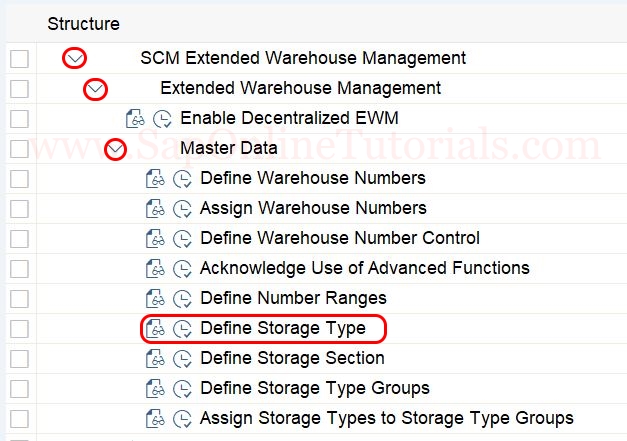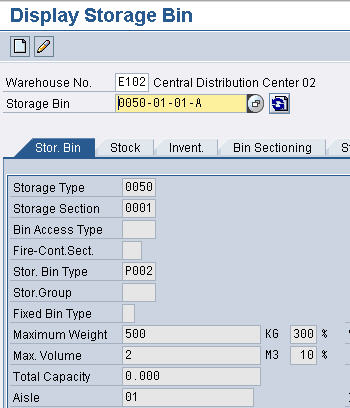The tolerance check determines whether the delivery quantity lies within the given tolerances for both inbound and outbound deliveries. Integration You define the tolerances for the delivery quantity in the reference document that is used to trigger the delivery process. CIFCWQTOLGR Data Element referenced by SAP EWM-CW: Catch Weight Tolerance Group for EWM fields with ABAP Data Type CHAR, Length 9. SAP ERP 6.0; SAP ERP Central Component 6.0; SAP Extended Warehouse Management 5.1; SAP Extended Warehouse Management 7.0; SAP Extended Warehouse Management 9.0; SAP Extended Warehouse Management 9.1; SAP Extended Warehouse Management 9.2; SAP Extended Warehouse Management 9.3; SAP Extended Warehouse Management 9.4; SAP Extended Warehouse Management 9.5; SAP enhancement package 1 for.
Features
Since catch weight products have both a logistics unit of measure and a catch weight unit of measure, the following areas of Extended Warehouse Management are affected:
Integration with SAP ERP
For more information about the integration of EWM and SAP ERP, see Integration with Catch Weight .
Product Master
For more information about catch-weight-related enhancements of the product master and about the different units of measure in EWM, see Changes in the Product Master and Units of Measure .
EWM Processes


For more information about catch weight enhancements with respect to goods movements, warehouse tasks, handling units, and so on, see Effects on Processes in EWM .
Delivery
For more information about delivery, see Catch Weight in the Delivery .

Physical Inventory
For more information about physical inventory, see Catch Weight in Physical Inventory .
Radio Frequency
Sap Ewm Wt Tolerance Definition
In Extended Warehouse Management (EWM), you can also process catch weight products using mobile data entry devices.

In the RF transactions, the system automatically checks in the background whether the product is a catch weight product or not. If the product is catch-weight-relevant, the system displays a corresponding catch weight indicator in the RF transactions. After the logistics quantity has been entered, the system automatically opens an additional screen for entering the catch weight quantity.
Sap Ewm Wt Tolerance List
This affects several different areas of the RF framework, such as deconsolidation, count entry, putaway, picking, packing, physical inventory, and ad hoc movements.
Quality Inspection
For more information, see Quality Inspection Using Catch Weight .
Warehouse Management Monitor
When catch weight products are evaluated in the warehouse management monitor, the quantity is displayed in the catch weight unit of measure in addition to the logistics unit of measure.
- Why IGZ
- Competences
- SAP Warehousing
- SAP Modules
- Best Practices
- SAP Transportation
- SAP Modules
- Best Practices
- SAP Automation
- SAP modules
- Best Practices
- SAP Manufacturing
- SAP modules
- Best Practices
- IGZ Customer Service
- SAP Warehousing
- SAP Modules
- Current events
- Company
The more parcels sent by a company, the more important it is to ensure that packing stations are using efficient working procedures. With the Extended SAP EWM Packing Station, useful support is offered to packing station teams. Weight data is read and applied automatically from scales, for example, and key items of information about the current parcel to be packed are displayed in large-format fields that are easy on the eye. The corresponding soft keys are ergonomically laid out and, helped by context-specific messages, considerably simplify the work of packing staff. As a result, parcels can be packed with SAP faster and with a lower incidence of errors.
Sap Ewm Wt Tolerance Test
Application areas of the extended packing station
Each packaging process begins with the posting of the picked goods from SAP EWM and takes place in parallel to the physical delivery of the goods to the packing station. Employees at the packing station use the delivery number to call up a delivery and see which items need to be packed. A scanning process is used to identify the packaging to which the items to be packaged can be assigned. A package counter and various additional functions then ensure that the correct shipment structure and the associated labels and printouts are generated. The required shipping documents are printed and packaged in the handling units for the physical unit of packaging and the products contained therein. The expected handling units in the respective transport process are now known.
Use
- All shipping functions integrated in SAP
- Elimination of additional subsystems for packaging
- Simplification of the system landscape, reduction of interfaces
- Complete turnkey solutions from IGZ
- Update Service: Product improvement
- Attractive fixed price offers for various services
- Fast return on investment
Fuctionality
- Dialogue-based guidance results in faster and safer processes
- Different packing modes:
- Highest speed
- 100% scanning
- Pick-and-pack
- Integration into existing hardware environments, e.g. weighing machines, printers, scanners
- Intuitive operation
- Touchscreen capability
- Pick&Pack function
- Clear detailed views
- Adaptation of packaging possible
- Filling management
- SAP standard evaluation options:
Orders + packages per day - Clear information: customer, delivery time, freight forwarder
- Configuration via parameter management
- Versatile adjustment options
- Multi-user capability/multi-scale capability